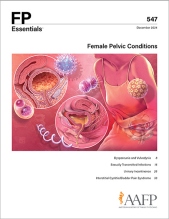
SECTION ONE
Dyspareunia and Vulvodynia
This clinical content conforms to AAFP criteria for CME.
Genito-pelvic pain/penetration disorder is a relatively new term encompassing both dyspareunia (recurrent pain with intercourse) and vaginismus (involuntary contraction of the pelvic floor with attempted penetration). Symptoms are often multifactorial. Thus, a detailed history and sensitive patient-centered examination are essential to identify and treat the underlying cause(s). Additional laboratory or imaging studies are not routinely indicated but may be helpful to rule out infectious etiologies or evaluate pelvic organ pathology in cases of deep dyspareunia. Treatment may include patient education about the condition, avoidance or modifications of irritants or triggers, use of vaginal lubricants and moisturizers, hormone therapy, pelvic floor physical therapy, and psychosocial interventions as indicated. Vulvodynia is a separate but related condition and is a diagnosis of exclusion. It is defined as vulvar pain for at least 3 months without another clearly identifiable cause. High-quality studies on the treatment of vulvodynia are limited. However, pelvic floor physical therapy and psychosocial interventions such as cognitive behavior therapy have the most consistent evidence of benefit.
Case 1. TL is a 54-year-old patient with diabetes that is well-controlled with metformin. She presents for a routine physical and cervical cancer screening. When asked about sexual health, she initially laughs and describes it as “nonexistent.” Asked for clarification, TL says she has not had vaginal sex for more than a year because it is too painful. She has tried several over-the-counter products to relieve pain and vulvar itching and burning without improvement. She says she has difficulty discussing this with you or her partner, but it causes significant personal and relationship distress.
Subscribe
From $350- Immediate, unlimited access to FP Essentials content
- 60 CME credits/year
- AAFP app access
- Print delivery available
Edition Access
$44- Immediate, unlimited access to this edition's content
- 5 CME credits
- AAFP app access
- Print delivery available

